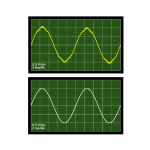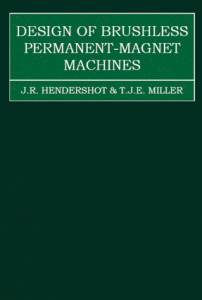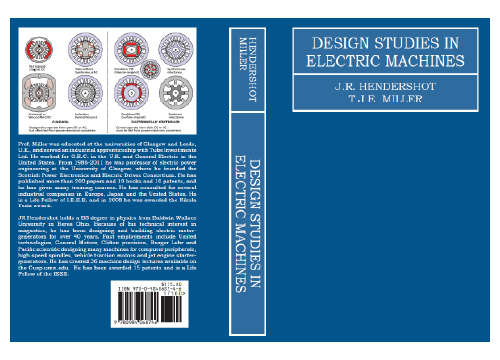![Fig. 1 Single-phase AC commutator motor [1888]](/jp/images/engineers_diary/engineers_diary_085a.png)
Fig. 1 Single-phase AC commutator motor [1888] 1
I can already hear a certain reaction to the idea of machines with carbon brushes:
‘We got rid of those many years ago’ .
That is true in many industries. It is even true that many modern electric motors and generators have no antecedents in commutator machines or slip-ring machines. So why should we show any interest in machines with carbon brushes?
If our scope is limited to the most aggressive high-performance machines using rare-earth magnets and sophisticated power-electronic controls, there doesn’t seem to be any reason—as long as the materials remain available and economic conditions continue to favour these ‘high-end’ products. Over 150 years of the electric machine industry, the march of progress towards the ‘high end’ has never wavered in spite of wars, depressions, great social and geopolitical changes, variations in price and scarcity of materials and labour, and even global warming. This is also reflected in the evolution of the analytical methods used to design machines. We seem never to have gone backwards.
Will this continue? Could the process even go into reverse?
Let’s attempt a brief thought-experiment, 2 in which we set the clock going backwards, and we watch what happens as we gradually lose some of the engineering assets on which we depend so heavily today. Treating this as a game, one important rule is that we can keep our survival instincts, and with them our habit of searching for ways and means of improvements and improvisations. For example when we reach the point where we lose our cell-phones, we’ll be allowed to use our land-lines instead (assuming that they are still intact and still working).
As we go backwards, one of the first things to go will be the hair-pin winding: not just the windings themselves but all the mass of expensive tooling required to make them. Imagine those factories gone, leaving bare earth or virgin forest or some industrial wasteland from a bygone age. We will have to set up our winding facilities with a mixture of old-fashioned tooling and manual methods. Surely it won’t be too bad: civilization went along very well without hair-pin windings for more than a century, so what is there to worry about? Without the benefit of computer software, will we be able to design windings to go with the legacy manufacturing methods and the legacy machine types? Our ancestors did it: so why shouldn’t we?
We only have to go back 20 or 30 years to lose the cell-phone and the hair-pin winding, but most of us probably worry more about losing rare-earth magnets. We have to go back about 40 years to lose those, or 50 – 55 years in the case of rare-earth/cobalt. Before that, high-performance permanent-magnet machines simply did not exist. Their roles were fulfilled by induction machines and synchronous machines in AC systems, and by DC commutator machines in DC systems (which were widespread in electric traction, diesel-electric traction, and industrial machinery). At the same time as we lose the rare-earth magnets we also lose the IGBT and the PWM-controlled current-regulated inverter, and field-oriented control goes out of the window as well. (We’re in the 1970s).
How were industry and society coping in those times of such severe privation? Actually very well, thank you. While the room for improvement was of course always present, it was generally hidden from view because it was in the future. In those days we could not imagine the future with rare-earth magnets and field-oriented control and SiC inverters, and so we didn’t miss them. We worked hard with what we had, and kept civilization afloat—some would say, in better condition that it is today. Of course there was smog and plenty of other kinds of pollution, coming from the use of coal as a primary fuel and other reasons, but most people put up with it in the same way that we still tolerate pollution and environmental damage in mining and manufacturing areas today. It was the price we paid for our living standards at the time (and still do).
My generation of engineers started our careers at the beginning of a time of enormous change. In my early days I remember knife switches on slate switchboards, Schräge motors, inductor alternators, Ward Leonard speed controls, ignitrons, wound-rotor induction motors, synchronous condensers, and of course DC motors galore, the most advanced of which were controlled by thyristor phase-controlled rectifiers; some of them were very big. As apprentices we were shown how to dress commutators (but not seriously entrusted with that magical art), and how to tune feedback systems on variable-speed drives (but again, not seriously entrusted with critical results!) One of the most impressive things I remember was the acceleration and deceleration (and the controllability) of DC servo motors used on machine tools: I simply did not believe my eyes when I saw how quickly they could respond. We weren’t missing anything. We were just fine. And yet most of this ‘stuff’ has gone. If by some awful circumstance civilization were driven back to those times, would we be able to cope?
Personally I like to think that we could cope extremely well. But getting back to the subject of carbon brushes, we would find that they were at the very heart of the most ingenious AC and DC machines ever invented, and we would also find that these machines had been around for 50 – 70 years, and so we would need to roll back the years a lot longer before we lost them. Of course we would also have to endure the miseries of bad commutation, worn commutators, worn brushes, and all the dust and the radio-frequency interference and even the fire hazard.
But the fascination level would have been at a historic peak, because of the importance of the commutator transformation and the theory of commutation in AC and DC machines, and the rich variety of specialty machines such as the Eichberg motor, the Scherbius and Kramer schemes, the rotary converters, and much else besides.
To bring this thought-experiment to a close, if we look around for DC and AC commutator motors today we may have the impression that there are very few, compared to two or three generations ago. Especially large machines are now rare, although they are still used in many places in rail traction. But many brush motors today are small ones driving windshield wipers, electric toothbrushes, and a huge variety of similar applications (including some high-performance motors in critical applications); see Fig. 2. Do they matter, and is there any interesting work to do in analysis and design? Absolutely yes and yes!

Fig. 2 Newly designed DC and brushless DC motor components awaiting assembly.
Courtesy of Motivity Ltd., Galashiels, UK; https://www.motivity.uk/
Let’s contemplate the significance of commutator and slip-ring machines not in terms of history but in terms of fundamental engineering principles.
In modern AC drives one of the most enduring legacies of the DC commutator motor is the two-axis concept that we recognize in terms of dq axes, the basis of field-oriented control theory for both synchronous and asynchronous AC drives. This structure arises naturally in the DC motor in terms of the actual currents, flux-linkages, and voltages of the field and armature circuits, but it does so only by virtue of the frequency-changing action of the commutator and brushes. As these are fixed mechanical elements of the machine, they can be treated directly in both the theory and in testing. All the basic theory of torque production, field-weakening, etc. can be expressed in terms of actual variables directly measurable at the terminals. With AC machines, however, the commutator transformation (Park’s transformation) is needed before we can apply the structure of field-oriented control in a manner that is analogous to that of DC machines. That’s not all. With the AC machine we may have to perform additional processes in simulation and control, to deal with a wide range of harmonic effects and the state-space switching of transistors at high frequency. But the underlying ‘dq-ness’ or ‘dq-character’, so to speak, remains.
Another legacy of the DC machine is the armature winding. One of the main differences is that in the DC machine—thanks to the action of the commutator—we use the maximum instantaneous flux-linkage of any coil, whereas in the AC machine we use only the fundamental time-harmonic, not only of individual coils but of the whole interconnected winding. There is a price to pay, in that the classical sinewave AC machine does not use all the flux, but only its working harmonic, and even that is filtered by the winding factor. All the other harmonics cause nothing but trouble—trouble that is essentially avoided in the DC machine.

Fig. 3 Example of DC motor analysis in JMAG (White Paper W-MO-13)
The effect of axial spreading of the flux in the saturated frame is important in small DC motors. It is a vivid example of axial-flux effects that are sometimes important in other types of motor.
Sometimes I wonder if modern battery technology might give the DC motor a new lease of life. It will help it to run longer, but it seems unlikely that battery improvements will precipitate a switch from AC motors to DC, as long as we have the electronics to drive them. To get variable speed we would need DC/DC converters, and it is not obvious that they would have any real advantage over modern AC inverters. The industry would regard it as a retrograde step. We might as well start dreaming about the possibility of AC batteries and other science-fiction.
When we “got rid of commutators” by switching to AC drives, did we get rid of commutation? Not at all! Maybe in the motors we did, but the terminal voltage now comes from an inverter which is a switchmode device, in which transistors switch on and off at high frequency. When they do, the current must commutate into freewheeling diodes—otherwise there will be overvoltage and failure of the power semiconductors. The commutation problem didn’t go away: it simply moved from the motor to the inverter. The design of power-electronic circuits could be described as the art of commutation, through the design of low-inductance freewheeling paths with specialised diodes, capacitors and other filter components, and even snubber circuits. In the DC motor a bit of sparking is often tolerable, whereas in a power-electronic circuit it usually means the end.
As apprentices years ago we would have no difficulty changing the brushes in the 6V DC generators on our motorbikes, or in the universal motors in our granny’s washing machine. In most cases the machines were designed to make it easy. Even in the factory, whether it was a steel mill or a colliery or a railway engineering workshop, changing brushes and dressing commutators were routine maintenance operations. We had jobs and we were happy. Nowadays this kind of homespun maintenance is rare. Mend it? Nah, throw it away and buy a new one. If the voltage is 800V instead of 12V, who is going to dare to try any maintenance?
Lastly, what about electromagnetic analysis of commutator machines? There are two aspects that may be of interest. Small DC motors with ferrite magnets often have different axial lengths for the armature (the rotor), the magnets, and the surrounding frame (or housing). The different lengths are intended to maximize the flux-linkage of the winding, and the magnet flux spreads in the axial direction while the frame tends to saturate quite heavily. This requires 3D magnetostatic analysis and it is very important because it determines the no-load speed and the torque constant, the two most important characteristic parameters of the motor. An example can be found in the JMAG documentation: see Fig. 3. 3
The second aspect is the analysis of commutation at the brush/commutator interface. This is a very complex process, especially in AC commutator motors (universal or series motors), and while conventional electromagnetic analysis is extremely useful in relation to the fields, inductances, induced voltages, etc., the complete simulation also requires a model of the arc that forms between the brush and the commutator segments. This is normally outside the scope of even the most advanced simulation software, requiring, as it does, empirical data and heuristic methods as we can see from the vast literature on this subject going back many years. We can see why engineers are glad to have ‘got rid of commutators years ago’, and why very few of us would want to bring them back; but just like old motorbikes or old pottery or old buildings, there is much about them that can still charm and fascinate the curious technical mind.
Notes and references
1 Fig. 1 is taken from R.M. Walmsley, Electricity in the Service of Man, Cassell & Company, London, 1904, Vol. I, p. 580. Walmsley died in 1924 but his publications are a rich source of detail about electrical technology up to about the time of the First World War. The motor in Fig. 1 was designed by Rechniewski, built in 1888: 100 A at 115 V, 1400 rev/min. Armature diameter 8 in (203 mm). Walmsley says ‘when running as an alternate-current motor it sparked furiously’.
2 https://en.wikipedia.org/wiki/Thought_experiment
3 JMAG 3D analysis of DC motor: https://www.jmag-international.com/whitepapers/w-mo-13/






